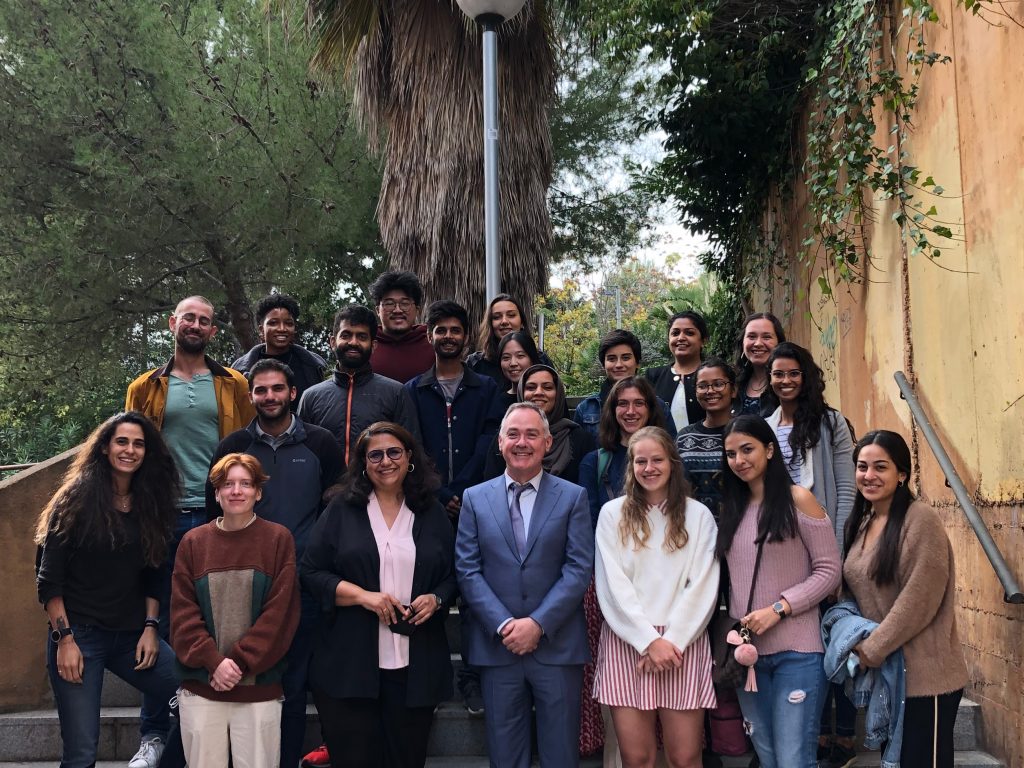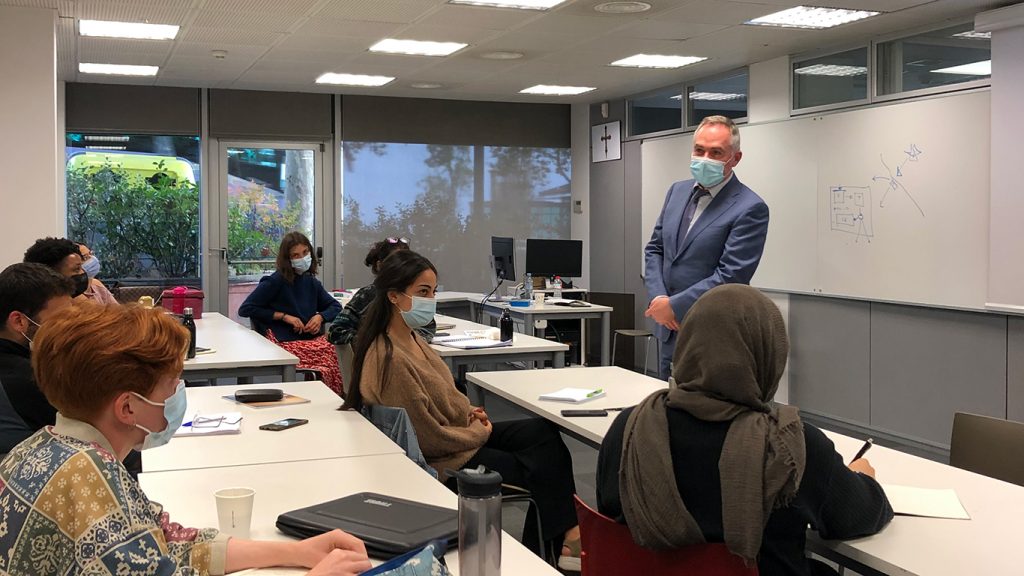On the last 22nd of October, we had Brett Moore as a guest professor of our program, we took this opportunity to interview him about humanitarian Architecture and the relevance of our practice in the current displaced crisis. He is Chief of Shelter and Settlement Section of the United Nations High Commissioner for Refugees, where he coordinates humanitarian shelter actors in both preparedness actions and disaster response. Prior to joining UNHCR, he was humanitarian shelter, infrastructure and reconstruction advisor with World Vision International, deploying to conflict and disaster zones around the world. He led teams to ensure a coordinated humanitarian response for significant global emergencies, and guided rebuilding efforts for disaster and conflict-affected communities ranging from refugee camps to urban slums.

You have worked for over 20 years in the emergency field, in post-disaster humanitarian aid, both in practice and academia. Your expertise as head of the Shelter and Settlement program of UNHCR focused on displaced populations by natural disasters, geopolitical conflicts, and, lately, environmental factors. As an architect, how do you see the relevance of our practice as designers to better understand and respond to communities at risk, and how did it shape your career?
Having a background in Architecture is primarily appreciated in the Humanitarian context; this disciplinary branch addresses the relationship between the built environment and peoples needs. In the humanitarian field, we usually work in the context of a natural disaster, a conflict, or an emergency scenario. It is often hard to firmly pay attention to the built landscape because other primal needs to be secured like health, education, nutrition or access to water. Therefore, agents specializing in urban planning and architecture are very needed because what happens in an emergency context is that people have lost their homes and need shelter. So, in this case, the understanding of architecture brings a set of critical tools: how the built environment works, how it is the construction process and how to allocate resources or communications. It brings comprehensive knowledge that helps organize the process. All these are skills that architects master, due to the cross-disciplinary means of architecture practice, always between humanities and science. That’s why I think that architects have a unique ability to work in the complexities of the humanitarian world.

People’s forced movements are one of the most significant challenges to be tackled in the upcoming years. That’s why at UNHCR, urban design has become one of the main strategies in the field. How will protracted settlements evolve concerning urban regions, thus reshaping their landscapes and demographics?
When you think about the UNHCR development, we need to acknowledge that they have been updated over seventy years, improving its qualities and capacities. Initially, it was intended to exist in a short-term scenario, giving response to specific cases taking place at that time. However, it has become a very relevant and consolidated institution because of the humanitarian crisis. I think that the role of technical disciplines inside the organization is very relevant nowadays because the phases of response and development are expanding. For example, when you look at refugee camps, now it is not only about solving first relief shelter necessities but the need to integrate them into communities. Hence, we are talking about design, construction and development. The necessities of shelter and forced settlements have become one of the world’s biggest concerns, and the specialization of the architectural profession reacting to these needs is Humanitarian Architecture. This specific branch of the discipline goes from the rapid response through emergency shelter into more transitional and long term settlements where we design housing or new urban developments.
When it comes to settlements, we implement a progressive intervention from the analysis to the construction. What is the nature of the refugee settlements? Is it a nascent town, is the beginning of a formal settlement? Or will the settlement be primarily temporary? This is the first approach from a technical perspective to address solutions in complex and variated emergencies. And I think this analytic strategy is fascinating to understand how cities evolve in this complicated political and social context of global movements and migrations. It is not just forcibly displaced populations moving towns around the world in large numbers, but a movement of people between the cities themselves through travels, work, business. These processes are linked, and they impact the fabric of the urban landscapes, the kind of buildings that are built, the kind of needs that are appearing. A new understanding of the culture within the city is rising, and it gets constantly redefined, influenced, diluted, reconnected. In this globalized culture of human movements, what does it mean to say ‘I am from Barcelona’ or ‘I am from Melbourne’, London, Nairobi… All cities are undergoing very similar processes of gentrification, disaster, recovery or reconstruction. We are in a very transitory time, and the city developments and demographics are reflecting that.
One of the critical aspects of our Master’s program is the socio-spatial integration of refugees. What of the last critical findings experienced in your organization can help us foresee a better socio-spatial integration strategies of these populations?
You are co-chair of the Global Shelter Cluster, where you are working on a global scale in the refugee’s crisis, coordinating the humanitarian shelter response joining several international agencies. Can you give a brief overview of the protocols that UNHCR tackles in the cases, explaining its engagement across scales?
The coordination level of the Shelter Cluster is chaired by UNHCR and National Federation of the Red Cross (NFRC). They have the overall coordination to look across all the national disasters, whereas UNHCR specializes in conflict-related contexts with people displaced. So we look at the big displacement crisis worldwide, and the areas where we have clusters activated, for example, Syria, Yemen, South Sudan, Ethiopia, etc. There we emphasize the coordination and the communication strategies on the field across actors and populations involved. When it comes to protocols, we first need to understand the nature of the project: we look at the number of agencies working on the territory, what are they focusing on, there is an emergency shelter or transitional shelter? Where are they working on, and what are their target groups? Secondly, we look at the geographical spread and aim to smooth out the bumps regarding allocating resources across all the affected areas. Consequently, we work in the gap analysis through data, reports, financial analysis. These technical reports are critical in making sure that the humanitarian response is efficient and meets peoples needs. Moreover, there is a coordination level with other sectors such as water, health, education or protection to guarantee that all responses work together. Finally, the main objective is to make sure we provide a fair and well-designed package of services that go directly to the refugees and ADPs in need. `
UNHCR is a network, and it is essentially a coordination mechanism. It doesn’t have a corporate structure. We work with all the partner agencies to support the responses that are under development. We spend most of our time on developing guidance, technical guidance. Therefore, we work with minimum standards of quality in the humanitarian response processes. We try to avoid duplication of efforts, distributing the resources efficiently. All the participating agencies must comprehend the complexity and nuances of the project we are working on, reach the ambitious relief goals, and take action in a common strategy. Each agency will respond in a unique way to its organization with its specificities, particular resources, skills, historical preferences, etc. In the end, it is a very cooperative model of governance.

Last year, we developed our field trip as an online format in Beirut and the American University of Beirut and the local NGO NUSANED. You were so kind as to give a talk to our students about this. Could you briefly describe the highlights and development of the emergency response after the Beirut blast in August 2020?
The participation of UNHCR in Beirut was mainly to support the coordination process and the technical response. We found very damaged buildings in dense areas, but we are not a construction company, so we tried to detect the blast’s actual impact in the city. At the beginning of the process, we tried to comprehend how many buildings were damaged and what kind of damage was. So we go through this taxonomic process and evaluate the damage into minor, medium and structural damage; then, we quantify it to estimate costs. The main goal of the Shelter program is to make sure people can return to their place of origin and live safely. That is why you want to have immediate results; what can be fixed quickly so the sites can return to their regular use? In the case of Lebanon, we witnessed the full engagement of citizenship; people were rebuilding their city, they are working hard. Paradoxically, it made it challenging to identify the need because it was changing all the time, so the re-evaluation was constant throughout all process. We spent around 23.000€ in three months on repairs, but also a lot of cash distribution, ensuring that vulnerable people have the resources to take care of themselves rapidly.
We got involved mainly in the rapid need assessment process at the beginning of the recovery. And then, we got heavily involved in the RRRF – Reform, recovery, reconstruction framework, which was meant to be an international investment process to reconstruct the port and other heavily damaged areas within the city centre. We put extreme attention at the heritage level because most of the affected area is the city’s historical centre; they have buildings from the Ottoman period or pre-1930. We emphasized that the humanitarian shelter response was sensitive to the cultural heritage to recover the original features. We worked with artisans and craftsmen to ensure that doors and windows, decorative plasterwork, and decorative tiles could repair and maintain their historical value. We employed mainly Syrian refugees artisans that knew the techniques and the handwork. There is a lot of work to be done, but we felt that the kind of work we have done together with partners was developing in the right way.
The last question for our students; how do you see the future of the architecture discipline concerning the humanitarian crisis, and how relevant is the engagement of young generations in this regard?
